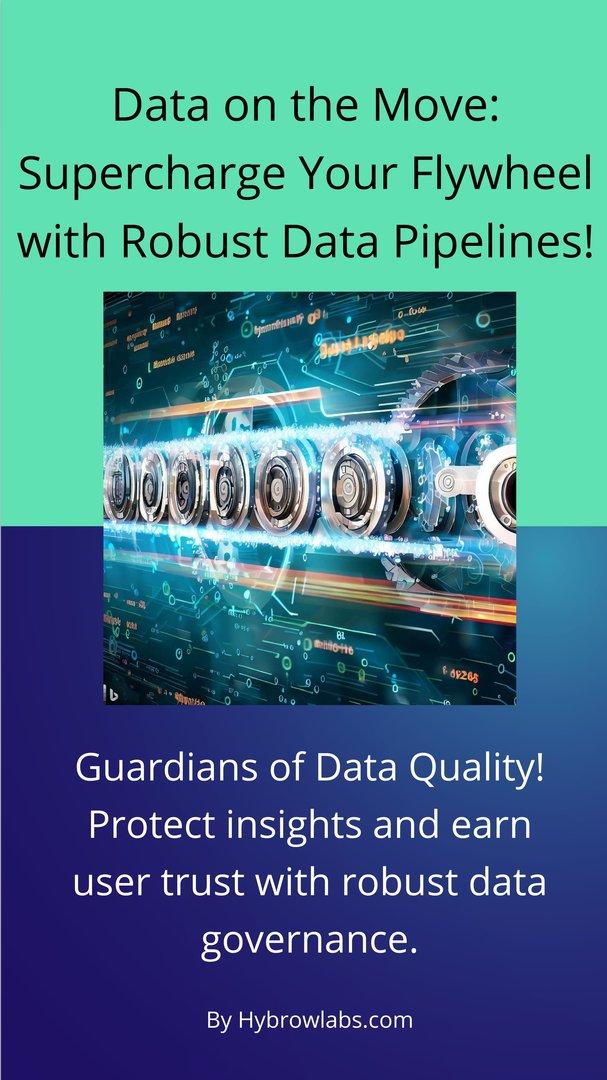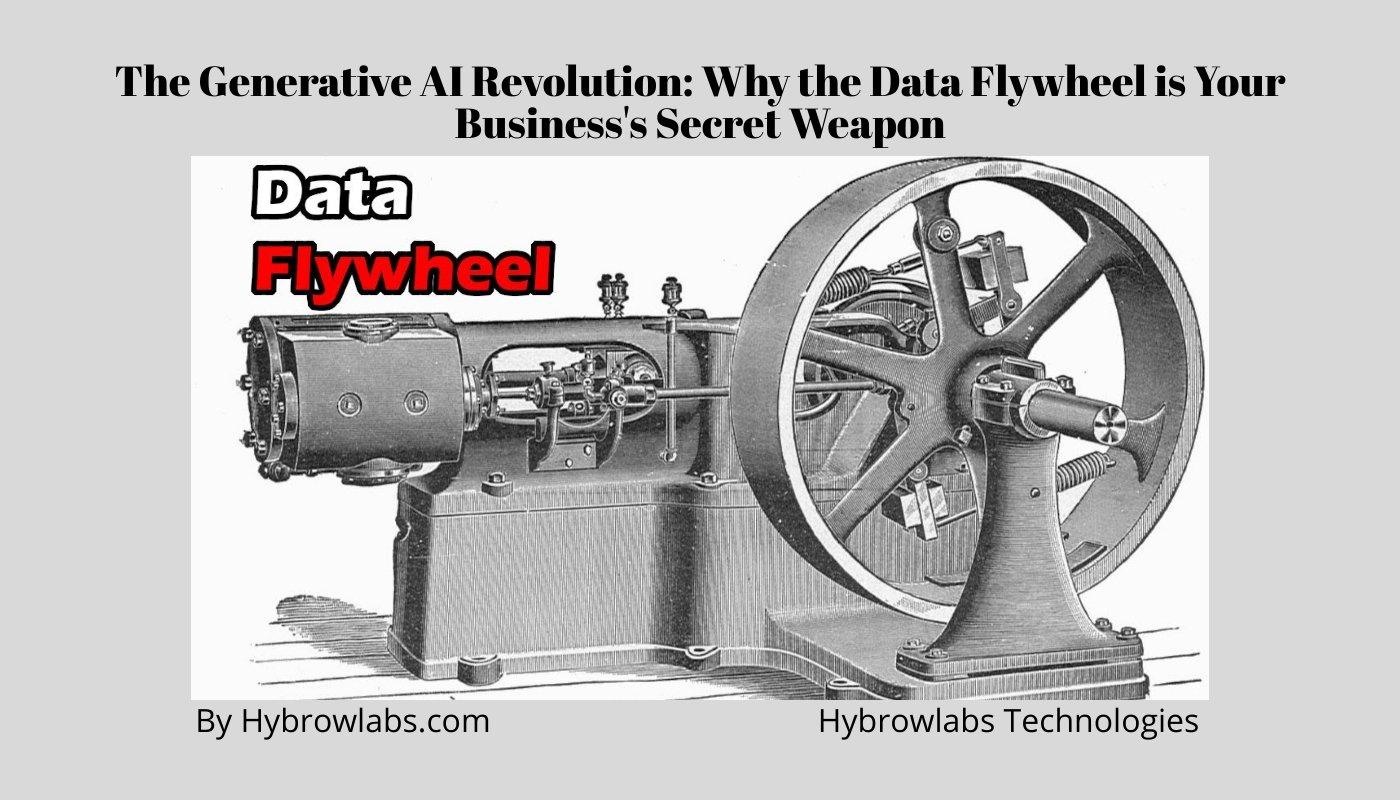In the age of AI, the concept of the data flywheel has emerged as a powerful tool for businesses. This article delves into the importance of the data flywheel and its role in driving exponential growth. By understanding the virtuous cycle of the data flywheel, businesses can harness the power of generative AI and leverage abundant data to propel their success. Additionally, we explore the history of flywheels, Amazon's adoption of the data flywheel, and the significance of generative AI as a data producer. By embracing the data flywheel, businesses can unlock their true potential in the AI-driven landscape.
Importance of the Data Flywheel in the Age of AI:

1. Fueling Exponential Growth:
- The data flywheel creates a self-reinforcing cycle, where user data leads to better AI, which in turn improves products and services.
- With compounding returns, businesses can experience exponential growth and gain a competitive edge in the market.
2. Leveraging User Data:
- By utilizing user data effectively, businesses can gain valuable insights into user preferences, behaviors, and needs.
- This data can drive innovation, enable personalized experiences, and inform strategic decision-making.
3. Enhancing AI Capabilities:
- The data flywheel feeds AI systems with more data, enabling them to learn and improve continuously.
- As AI algorithms become more refined, businesses can deliver better recommendations, predictions, and solutions.
4. Building a Sustainable Competitive Advantage:
- Embracing the data flywheel helps businesses establish a strong data-driven culture, which becomes a valuable asset.
- The accumulated data and AI capabilities create a moat that competitors find hard to replicate, leading to a sustainable advantage.
Understanding the Data Flywheel and its Virtuous Cycle in Business
1. User Acquisition:
- Businesses acquire users through various channels, such as marketing campaigns, referrals, or organic growth.
2. Data Collection:
- User interactions generate valuable data points, including preferences, behaviors, and feedback.
- Businesses collect and store this data, ensuring comprehensive and secure data management practices.
3. AI Development:
- The collected data fuels the development and training of AI models, enabling businesses to gain insights and make predictions.
- AI algorithms process and analyze the data, extracting patterns and generating actionable intelligence.
4. Product and Service Improvement:
- The insights derived from AI are utilized to enhance existing products and services, tailor offerings to customer needs, and identify new opportunities.
- This iterative improvement drives customer satisfaction and loyalty, leading to increased user engagement and retention.
5. User Expansion:
- Enhanced products and services attract new users, creating a growing customer base.
- As the user base expands, more data is generated, initiating a continuous cycle of improvement and growth.
Origins and Uses of Flywheels Throughout History
1. Early Applications
- Flywheels have been used for centuries in various applications, such as pottery wheels and sharpening devices.
- These early flywheels demonstrated the concept of storing rotational energy for improved performance.
2. Modern-day Applications:
- Flywheels find applications in engines, race cars, and electromechanical or chemical mechanical devices.
- They serve to smooth out performance, store energy, and act as generators during power loss.
Relevance of Flywheels in Modern-day Applications

1. Engine Efficiency
- Flywheels are integral components in large diesel engines, reducing fluctuations and ensuring consistent performance.
- They contribute to energy conservation and provide stability during operation.
2. Mechanical Systems:
- Flywheels are crucial in various mechanical systems, such as industrial machinery, to regulate speed and provide stability.
- They store and release energy when required, improving overall efficiency.
The Data Flywheel and Amazon's Success
A. Data Flywheel Concept Pitched to Jeff Bezos in 2003:
Jeff Bezos recognized the importance of using data as a strategic asset and coined the term "data flywheel." He emphasized the need to collect and utilize customer data to enhance user experience and drive business growth. Amazon's AWS Implementation of the Data Flywheel and its Role in Their Success:
Amazon's relentless focus on customer data and AI has powered its growth and dominance in the e-commerce industry. They leverage data to personalize recommendations, optimize supply chains, and streamline operations. The virtuous cycle of the data flywheel has allowed Amazon to continually refine its offerings and stay ahead of competitors.
Generative AI as a Data Producer

1. Understanding Generative AI as a Source of Abundant Data:
Generative AI models, such as GANs (Generative Adversarial Networks), produce synthetic data that resembles real-world data. These models can generate images, text, and other data types, providing businesses with a wealth of additional training and testing data.
2. The Importance of Recording and Saving all Generated Data:
- Every data point generated by generative AI has the potential to provide valuable insights and improve AI algorithms.
- Businesses should establish robust data storage and management practices to preserve and utilize this generated data effectively.
Leveraging the Data Flywheel for Business Growth
The data flywheel concept holds immense potential for driving business growth in the age of AI. By leveraging this powerful concept, businesses can unlock compounding returns and achieve exponential growth. Here are key points to consider when implementing the data flywheel strategy:
A. Case study: Personal experience of utilizing the data flywheel for exponential subscriber growth
In this section, we will explore a real-life example of how the data flywheel was successfully utilized to achieve substantial subscriber growth. The case study will highlight the specific steps taken to harness user feedback, insights, and data to shape strategies that led to exponential growth.
B. Importance of analyzing user feedback and insights to shape business strategies
User feedback is a valuable resource that can provide deep insights into customer preferences, needs, and expectations. By analyzing user feedback, businesses can gain a better understanding of their target audience, identify trends, and develop strategies that align with user preferences.
Implementing the Data Flywheel in Your Business
To effectively implement the data flywheel concept, businesses should follow certain guidelines and best practices. Here are key points to consider when implementing the data flywheel strategy:
A. Recording and utilizing comprehensive data
To fuel the data flywheel, it is essential to record comprehensive data, not just the output from AI models. This includes capturing input data, output data, metadata, context, and parameters. By recording and leveraging this comprehensive data, businesses can gain deeper insights and make more informed decisions.
B. Making data-driven changes and avoiding data storage without utilization
Recording data is not enough; it is crucial to actually use the data. Many businesses have large amounts of stored data that they never analyze or utilize effectively. To leverage the data flywheel, businesses must actively analyze and act upon the data they have collected.
C. Embracing iterative improvement and adaptation
Iterative improvement is a fundamental aspect of the data flywheel strategy. Businesses should be open to experimentation, learning from failures, and continuously iterating to optimize their processes, products, and services.
D. Exploring frameworks such as Agile, Kaizen, Six Sigma, and ITIL for data-centric processes
Frameworks like Agile, Kaizen, Six Sigma, and ITIL provide valuable methodologies for implementing data-centric processes. Businesses can benefit from adopting these frameworks to drive efficient data utilization, process improvement, and organizational transformation.
Preparing for Data Flywheel Success - Understanding Service Foundation Before Implementing the Data Flywheel

a. The importance of a strong product or service offering
- The data flywheel is a powerful tool, but it requires a solid foundation to be effective.
- Without a valuable product or service, the data flywheel will lack the necessary momentum.
- Focus on developing a high-quality offering that meets customer needs and generates interest.
b. Building a user base
- A data flywheel relies on users to generate data and drive growth.
- Attracting and retaining users is essential for the success of the data flywheel.
- Prioritize user acquisition and engagement strategies to fuel the flywheel's momentum.
c. Creating a feedback loop
- Establish channels for gathering user feedback and insights.
- Feedback loops help identify areas for improvement and provide valuable data for the flywheel.
- Encourage users to share their experiences, suggestions, and concerns.
The Significance of Executive Leadership Buy-in for Iterative Improvement
a. Embracing a culture of continuous improvement
- Executive leadership plays a crucial role in fostering a culture of iterative improvement.
- Encourage a mindset that embraces change, experimentation, and learning from failures.
- Leaders must set the example by actively engaging in iterative processes themselves.
b. Allocating resources and support
- Executives need to allocate resources and support for data-driven initiatives.
- Provide teams with the necessary tools, technology, and training to leverage data effectively.
- Foster a collaborative environment where teams can experiment and innovate.
c. Championing data-driven decision-making
- Executives should promote the use of data in decision-making processes.
- Encourage teams to rely on data rather than relying solely on intuition or past experiences.
- Develop data literacy across the organization to ensure everyone can understand and leverage data.
Powering up the Data Flywheel - Importance of establishing robust data pipelines

a. Building a scalable infrastructure
- Implement a robust data infrastructure to handle large volumes of data.
- Design data pipelines that can process, store, and analyze data efficiently.
- Scalable infrastructure ensures the flywheel can handle increasing data demands.
b. Ensuring data quality and security
- Data quality and security are critical for reliable insights and user trust.
- Implement data governance practices to maintain data integrity.
- Protect user privacy and comply with relevant data protection regulations.
c. Leveraging advanced analytics and AI
- Utilize advanced analytics techniques and AI algorithms to derive valuable insights from data.
- Machine learning and AI can help automate data processing, analysis, and decision-making.
- Incorporate generative AI technologies to leverage the full potential of the data flywheel.
Mantras to adopt for successful data flywheel implementation
a. Data is the new oil
- Recognize the value and potential of data as a strategic asset.
- Treat data as a valuable resource that can fuel growth and innovation.
- Invest in data collection, storage, and analysis capabilities.
b. Slow is smooth, smooth is fast
- Start the data flywheel implementation gradually to ensure a smooth transition.
- Focus on building momentum over time rather than rushing to achieve immediate results.
- Gradual acceleration allows for learning, adjustments, and continuous improvement.
c. Garbage in, garbage out
- Ensure data quality by collecting and using relevant, accurate, and reliable data.
- Avoid relying on low-quality or irrelevant data that can hinder insights and decision-making.
- Quality data inputs lead to meaningful outcomes and improvements.
Conclusion
In conclusion, the data flywheel represents a powerful concept that can drive exponential growth and success for businesses in the age of AI. However, its effectiveness relies on a solid product or service foundation and the support of executive leadership. By understanding the need for a strong foundation, executive buy-in for iterative improvement, and implementing robust data pipelines, businesses can power up their data flywheels. With their expertise in data engineering, machine learning, and analytics, Hybrowlabs can assist businesses in building the foundation and infrastructure necessary for a successful data flywheel. To learn more about Hybrowlabs and their services, you can visit our website.
FAQ
1. What is the generative AI revolution, and how does it relate to the data flywheel?
The generative AI revolution refers to the significant advancements in artificial intelligence that enable machines to generate creative and novel content, ideas, or solutions. The data flywheel, on the other hand, represents the iterative process of collecting, analyzing, and leveraging data to drive business growth. The generative AI revolution can be seen as a powerful tool within the data flywheel, as it can generate new insights, ideas, and innovations from the vast amounts of data accumulated over time.
2. How does the data flywheel serve as a secret weapon for businesses?
The data flywheel serves as a secret weapon for businesses because it harnesses the power of data to drive continuous improvement, innovation, and competitive advantage. By implementing a data flywheel, businesses can leverage the insights gained from data to make informed decisions, optimize processes, enhance products or services, attract more customers, and ultimately accelerate their growth trajectory. It provides a systematic and iterative approach to leveraging data as a strategic asset, giving businesses a significant edge in the market.
3. What role does executive leadership play in the success of the data flywheel?
Executive leadership plays a crucial role in the success of the data flywheel. They are responsible for setting the strategic direction and vision for the organization, and their buy-in and support are essential for driving a data-driven culture. Executives can provide the necessary resources, support, and guidance to establish robust data pipelines, promote data governance practices, and foster a culture of continuous improvement and experimentation. Their commitment to leveraging the data flywheel as a strategic asset can inspire and empower teams across the organization to embrace data-driven decision-making and unlock its full potential.
4. How important is it to establish robust data pipelines for a successful data flywheel implementation?
Establishing robust data pipelines is crucial for a successful data flywheel implementation. Data pipelines ensure the efficient and reliable flow of data from various sources to storage, analysis, and application layers. A well-designed and scalable data pipeline enables businesses to collect, process, and analyze large volumes of data in real-time, ensuring the availability of accurate and timely insights. Robust data pipelines also facilitate data quality assurance, data integration, and data security, which are vital for deriving meaningful insights and making informed decisions within the data flywheel.
5. What are some key mantras to adopt for successful data flywheel implementation?
There are several key mantras to adopt for successful data flywheel implementation. One mantra is "data-driven decision-making," emphasizing the importance of using data and insights as a foundation for making informed choices. Another mantra is "continuous improvement and iteration," highlighting the need to embrace an iterative approach and continuously refine processes, products, and strategies based on data-driven insights. Additionally, "cultivating a data-driven culture" encourages organizations to foster a mindset of curiosity, experimentation, and learning from data. By adopting these mantras, businesses can effectively harness the power of the data flywheel and drive sustainable growth and innovation.






a3dc85.jpg)
.jpg)
fd8f11.png)


.jpg)
.jpg)